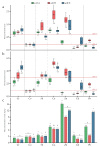Phytoremediation of Soil Contaminated by Organochlorine Pesticides and Toxic Trace Elements: Prospects and Limitations of Paulownia tomentosa
- PMID: 36006144
- PMCID: PMC9415570
- DOI: 10.3390/toxics10080465
Phytoremediation of Soil Contaminated by Organochlorine Pesticides and Toxic Trace Elements: Prospects and Limitations of Paulownia tomentosa
Abstract
Paulownia tomentosa (Thunb.) Steud is a drought-resistant, low-maintenance and fast-growing energy crop that can withstand a wide range of climatic conditions, provides a high biomass yield (approximately 50 t DM ha-1 yr-1), and develops successfully in contaminated sites. In Kazakhstan, there are many historically contaminated sites polluted by a mixture of xenobiotics of organic and inorganic origin that need to be revitalised. Pilot-scale research evaluated the potential of P. tomentosa for the phytoremediation of soils historically contaminated with organochlorine pesticides (OCPs) and toxic trace elements (TTEs) to minimise their impact on the environment. Targeted soils from the obsolete pesticide stockpiles located in three villages of Talgar district, Almaty region, Kazakhstan, i.e., Amangeldy (soil A), Beskainar (soil B), and Kyzylkairat (soil K), were subjected to research. Twenty OCPs and eight TTEs (As, Cr, Co, Ni, Cu, Zn, Cd, and Pb) were detected in the soils. The phytoremediation potential of P. tomentosa was investigated for OCPs whose concentrations in the soils were significantly different (aldrin, endosulfans, endrin aldehyde, HCB, heptachlor, hexabromobenzene, keltan, methoxychlor, and γ-HCH) and for TTEs (Cu, Zn, and Cd) whose concentrations exceeded maximum permissible concentrations. Bioconcentration (BCF) and translocation (TLF) factors were used as indicators of the phytoremediation process. It was ensured that the uptake and translocation of contaminants by P. tomentosa was highly variable and depended on their properties and concentrations in soil. Besides the ability to bioconcentrate Cr, Ni, and Cu, P. tomentosa demonstrated very encouraging results in the accumulation of endosulfans, keltan, and methoxychlor and the phytoextraction of γ-HCH (TLFs of 1.9-9.9) and HCB (BCFs of 197-571). The results of the pilot trials support the need to further investigate the potential of P. tomentosa for phytoremediation on a field scale.
Keywords: Paulownia tomentosa; bioconcentration factor; organochlorine pesticides; phytoremediation; toxic trace elements; translocation factor.
Conflict of interest statement
The authors declare no conflict of interest.
Figures




Similar articles
-
Comprehensive assessment of unutilized and obsolete pesticides impact on genetic status and health of population of Almaty region.Ecotoxicol Environ Saf. 2020 Oct 1;202:110905. doi: 10.1016/j.ecoenv.2020.110905. Epub 2020 Jul 4. Ecotoxicol Environ Saf. 2020. PMID: 32800240
-
Phytoremediation potential of Miscanthus sinensis And. in organochlorine pesticides contaminated soil amended by Tween 20 and Activated carbon.Environ Sci Pollut Res Int. 2021 Apr;28(13):16092-16106. doi: 10.1007/s11356-020-11609-y. Epub 2020 Nov 27. Environ Sci Pollut Res Int. 2021. PMID: 33245538
-
Possibility for using of two Paulownia lines as a tool for remediation of heavy metal contaminated soil.J Environ Biol. 2015 Jan;36 Spec No:145-51. J Environ Biol. 2015. PMID: 26591894
-
Trace elements in agroecosystems and impacts on the environment.J Trace Elem Med Biol. 2005;19(2-3):125-40. doi: 10.1016/j.jtemb.2005.02.010. Epub 2005 Oct 24. J Trace Elem Med Biol. 2005. PMID: 16325528 Review.
-
Phytoremediation as a management option for contaminated sediments in tidal marshes, flood control areas and dredged sediment landfill sites.Environ Sci Pollut Res Int. 2009 Nov;16(7):745-64. doi: 10.1007/s11356-009-0205-6. Epub 2009 Jun 16. Environ Sci Pollut Res Int. 2009. PMID: 19533193 Review.
Cited by
-
Case-Control Study of the Association between Single Nucleotide Polymorphisms of Genes Involved in Xenobiotic Detoxification and Antioxidant Protection with the Long-Term Influence of Organochlorine Pesticides on the Population of the Almaty Region.Toxics. 2023 Nov 21;11(12):948. doi: 10.3390/toxics11120948. Toxics. 2023. PMID: 38133349 Free PMC article.
References
-
- Nurzhanova A., Kulakow P., Rubin E., Rakhimbayev I., Sedlovskiy A., Zhambakin K., Kalugin S., Kolysheva E., Erickson L. Obsolete Pesticides Pollution and Phytoremediation of Contaminated Soil in Kazakhstan. In: Kulakow P.A., Pidlisnyuk V.V., editors. Application of Phytotechnologies for Cleanup of Industrial, Agricultural, and Wastewater Contamination. Springer; Dordrecht, The Netherlands: 2010. pp. 87–111. (NATO Science for Peace and Security Series C: Environmental Security).
Grants and funding
LinkOut - more resources
Full Text Sources
Research Materials

